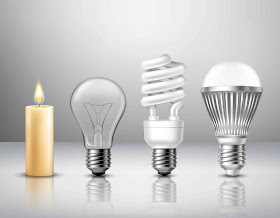I'd written two years ago about the pervasiveness of light emitting diodes for holiday decorations. While revising some notes for my class on nanoscience and nanotechnology, I recently came upon some numbers that really highlight the LED as a great example of condensed matter (and recently nanoscience) having a serious positive impact on energy consumption and environmental impacts.
 |
| Image from here. |
Back when I was growing up, incandescent light bulbs were common, and pretty lousy at generating light for a given amount of energy input. Incandescents produce something like 20 lumens/W, while compact fluorescent bulbs are more like 60 lm/W. In contrast, LED lighting is well over 100 lm/W and is hitting numbers like 200 lm/W in more expensive bulbs, and in theory could reach more like 325 lm/W. (For good sources of information about this, I recommend this report by the International Energy Agency, and this 2020 report (pdf) from the US Department of Energy. LED "white" lighting works either by having a UV LED that excites the same kind of phosphors that are in fluorescent bulbs, or by "color mixing" through having red, green, and blue LEDs all in one package. (The "nano" comes into this both through the precision growth of the semiconductors and in some cases nanostructuring to enhance the fraction of emitted light that actually gets out of the LED.)
Six years ago, lighting accounted for about 15% of global electricity demand. In just a few years, LEDs have gone from a few % of market share for new lighting to well above 50% of market share, and there is no sign of this slowing down. The transition to LEDs is expected to save hundreds of billions of dollars per year in energy costs, gigatons per year in CO2 emissions, and to stave off the need to construct over a hundred new municipal-scale power plants over the next decade.
This is a big deal. One way to cast "the energy problem" is that there is no clear, environmentally reasonable path toward raising the standard of living of billions of people up to the level of per capita energy consumption seen in the most developed economies. Cutting that per capita energy use would be great, and LED lighting is a true success story in that regard.
Interesting. Maybe I should look at buying some LED manufacturers’ stock…
ReplyDeletePPP, LEDs have become a commodity business and many pioneers like Cree (Wolfspeed) have sold off or shut down their LED businesses.
ReplyDeleteWolfspeed is now focused on Silicon Carbide and Gallium Nitride based power electronics and RF electronics. Wide band gap based power electronics is another example of solid state physics resulting in efficiency gains.
ReplyDelete